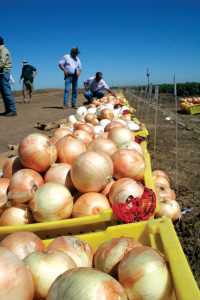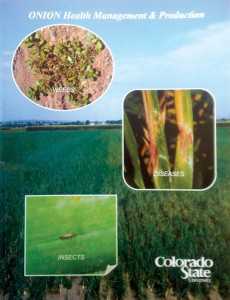Pathologist Offers IPM Strategies For Onion Growers
If Howard Schwartz could give onion growers one piece of advice on how to avoid headaches in the future, whether from insects or diseases, it would be to clean up their act.

Photo Credit: David Eddy
“Whether it’s onion roots, bulbs, or foliage, getting rid of previous crop debris will really reduce the year-in and year-out problems they have to deal with, whether from bugs or diseases or whatever,” says the Colorado State University professor of plant pathology. “That’s one of the big ways a farmer can help himself, by cleaning up his house.”
Because problems from previous crop debris can be so serious, such as botrytis, downy mildew, and onion maggots, growers have to really pay attention. The nature of the crop itself adds to the difficulty. “Bulbs don’t deteriorate,” he says, “and they will start to grow again in spring and start a new disease cycle.”
Schwartz ought to know. He recently edited a new book, Onion Health Management and Production, that features contributions from top onion experts from throughout the U.S. (See “Free New Book Available.”)
Common Problems
The new book, which at just over 100 pages and loaded with photos and charts is extremely accessible, is intended for onion growers of all types — whether small or large acreage, organic or conventional. After all, many problems encountered by onion growers are widespread. For example, soil-borne diseases like pink root and fusarium are all too common. “Those two are pretty universal threats to the onion industry in the U.S.,” says Schwartz.
Asked for his list of top issues among the threats in the various categories, he cited the following: disease, iris yellow spot virus; insect, onion thrips; and weed, yellow nutsedge. That said, however, onions are grown in a lot of disparate places in the U.S., and there are quite a few regional differences.
For example, while onion growers in the West might struggle with Canada thistle, they might never even see a nemesis of growers in the Southeast, Florida beggarweed. As with weeds, there can be strong regional differences in insect threats. While thrips might be the top insect problem in U.S. onions, it is closely followed by maggots in some areas, such as New York and Michigan. In the West, however, maggots are generally just a minor problem.
But if a problem is serious, whether from insects, weeds, or diseases, there is only so much an onion grower can do, says Schwartz. “If it’s a continuing problem, rotate out of onions for two or three years,” he says. “As an IPM person, I advocate crop rotation.”
Click on the following page to read about Howard Schwartz’s new IPM book.
Free New Book Available
The Onion ipmPIPE (Pest Information Platform for Extension and Education) Project and Colorado State University have announced that the new publication, Onion Health Management and Production, is available upon request at no charge.

The 104-page, full color bulletin was written by a national team of 20 onion experts dedicated to the enhancement of onion production and pest management as part of a USDA Specialty Crop Research Initiative project and the Colorado Integrated Pest Management Program.
The bulletin provides highlights on common production practices and integrated pest management strategies in use by progressive onion growers and the industry throughout the U.S. Resources developed by the Onion ipmPIPE project in recent years are featured in the bulletin, which includes:
- Onion growth stages
- Pest and disease diagnostic aids
- Plant damage scales
- Pest and disease occurrence charts
Free copies are available by contacting the editor, Howard Schwartz, Colorado State University: [email protected].









